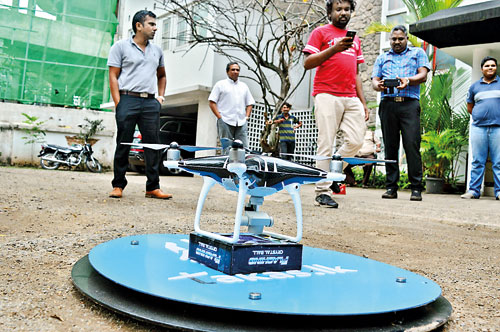Takas.lk drone deliveries is the next new ‘thing’
View(s):
Lahiru Pathmalal (left) during testing of the drone.
Takas.lk the online marketing firm has cottoned onto an innovative delivery idea – use of drones.
In a bid to see if a drone can carry a load of up to 250 grammes, a test run was done to ascertain the viability of delivering orders in Colombo through this process, limited to this weightage.
“We wanted to be the first to do it,” Lahiru Pathmalal, CEO Takas told the Business Times. He said that the company wanted to pioneer with the ‘existing technology’ and do something different. “We wanted to see if we can push the boundaries,” he said.
This cost is apparently next to nothing as they had used only off the shelf hardware and a “state-of-the-art cello tape based package attachment mechanism” to get the prototype ready as soon as possible with limited resources.
In a drone there’s no complete human contact, Mr. Pathmalal says noting that the Civil Aviation Authority (CAA) has said that they can sanction those deliveries within 500 metres.
To better comprehend this – there’re three types of distances in deliveries. The first is the first mile which is picking a product/package from the supplier. The middle mile is when it’s picked from a dispatch centre and the last mile is when it’s deliv ered to the customer from the dispatch (centralised place). “So as doing the last mile will be difficult (due to varying distances) we’re trying to get clearance for the middle mile,” Mr. Pathmalal says.
Drones have continued to capture our imagination in remarkable ways with the pace of interest in these little flying robots in general discussions in technology and science . What Takas wants to do next is to buy or build a commercial drone. They are in discussion with engineer, Tilak Dissanayake, the only person trying to build one.
Despite the thick layers of bureaucracy there are more and more fresh ideas to put the technology to use. He says drones that could deliver medical supplies to Nuwara Eliya for example would be very cost effective (because of the distance covered).
There may be other cool things such as delivering a blood organ that far, he says noting that it’ll cut the cost of transport significantly. “It’ll probably be one fiftieth of the cost and the speed is the most important.”
Currently, there are operations that use drones to deliver goods. DHL pioneered commercial delivery with a 1 kg package to an island 12 km off the German coast almost three years ago. The more recent example is Zipline which delivers 150+ blood packs per day to 21 hospitals in Rwanda. Dubai just announced that they will have a one-person air taxi service by July this year. India delivers pizza.
Mr. Pathmalal says that if the state recognises the established viability of using drones, it’ll be a life saving situation for fisherman.
He adds that amongst the lessons learnt are that terrain and building height data are currently insufficient and the package size and how it effects the airflow around the drone is equally important to the weight distribution. “We faced a few stability issues because the package was blocking air flowing downwards. Deliveries can we done extremely fast, avoiding traffic,” he says noting, “We need to work with authorities on getting clearance for deliveries”.
It’s going to fascinating to watch this technology continue to evolve and at some point or another, be deployed on a grand scale. (DE)


